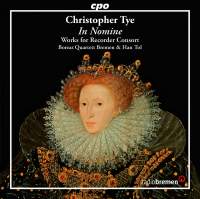Texte paru dans: / Appeared in:
|
|
|
Outil de traduction ~ (Très approximatif) |
|
|
Reviewer: James
A. Altena Christopher Tye (c. 1505–c. 1573) remains biographically obscure. The first undisputed known record of him is his receipt of a Bachelor’s degree in music at Cambridge, from which are conjectured his approximate date and likely place of birth. (If the “Tye” listed as a choirboy at Cambridge in 1511–12 was Christopher, he may have been born as early as c. 1497.) In 1537 he became a lay clerk at King’s College; in 1543 he assumed the position of master of the choir at Ely Cathedral, while taking a doctorate in music from Cambridge in 1545. From his only publication during his lifetime— The Actes of the Apostles (1553), a verse synopsis in four-part harmony of the first 14 chapters of the NT history—it has been inferred that he held some sort of court appointment during the early 1550s; he may have been a personal music tutor to King Edward VI (the dedicatee of his book). After being out of favor during the reign of Queen Mary due to his staunch Protestant sympathies, in 1559 he resumed his position at Ely Cathedral, but left both it and all musical endeavors behind by late 1560 to be ordained a priest in the Church of England by Richard Cox, the bishop of Ely and a longtime personal friend. (His successor at Ely, Robert White, may have become his son-in-law, if the Ellen Tye that White married in 1565 was Tye’s daughter.) Tye was appointed rector of Doddington, Cambridgeshire, then one of the wealthiest benefices in England, at which point he largely vanishes from the historical record, his date of death being inferred from appointment of a successor to that position. Fairly little of his music survives intact: three Mass settings, some anthems, motets, psalm settings, and hymns, and some chamber music works such as the ones featured here. (On a side note, Tye’s son Peter fraudulently obtained ordination and the rectorship of Trinity Church, Ely, a matter that resulted in charges being preferred against Bishop Cox; for these and other matters that incurred Queen Elizabeth’s displeasure, Cox was forced to resign his episcopal see in 1580, a year before his death.) This is not the only recording of Tye’s collected In nomine settings (21 total); in 38:5 colleague Barry Brenesal reviewed a CD of them performed by the Spirit of Gambo viol consort. The original In nomine, a section of the Sanctus from the Mass setting Gloria tibi Trinitas of John Taverner (1490–1545), was seized upon by numerous subsequent English composers to the point that such settings became a distinct genre of their own. Quite sensibly, the present disc offers a transcription of Taverner’s original for four-part recorder consort before launching into Tye’s 21 adaptations of it, supplemented by transcriptions of eight other works. The Boreas Quartett Bremen consists of four women recordists, all pupils of Han Tol, who in turn adds a fifth recorder part to all the tracks except 1 (the Taverner excerpt) and 11 (an In nomine à 4). The playing is exquisitely polished and ideally recorded, and CPO provides its usual detailed booklet notes. Whether you acquire this CD or the one reviewed by Brenesal is a matter of subjective preference for which type of instrumental consort you prefer. I would be delighted with either, and am most happy to have this one; enthusiastically recommended. | |
|
|
|
|
Cliquez l'un ou l'autre
bouton pour découvrir bien d'autres critiques de CD |
|




